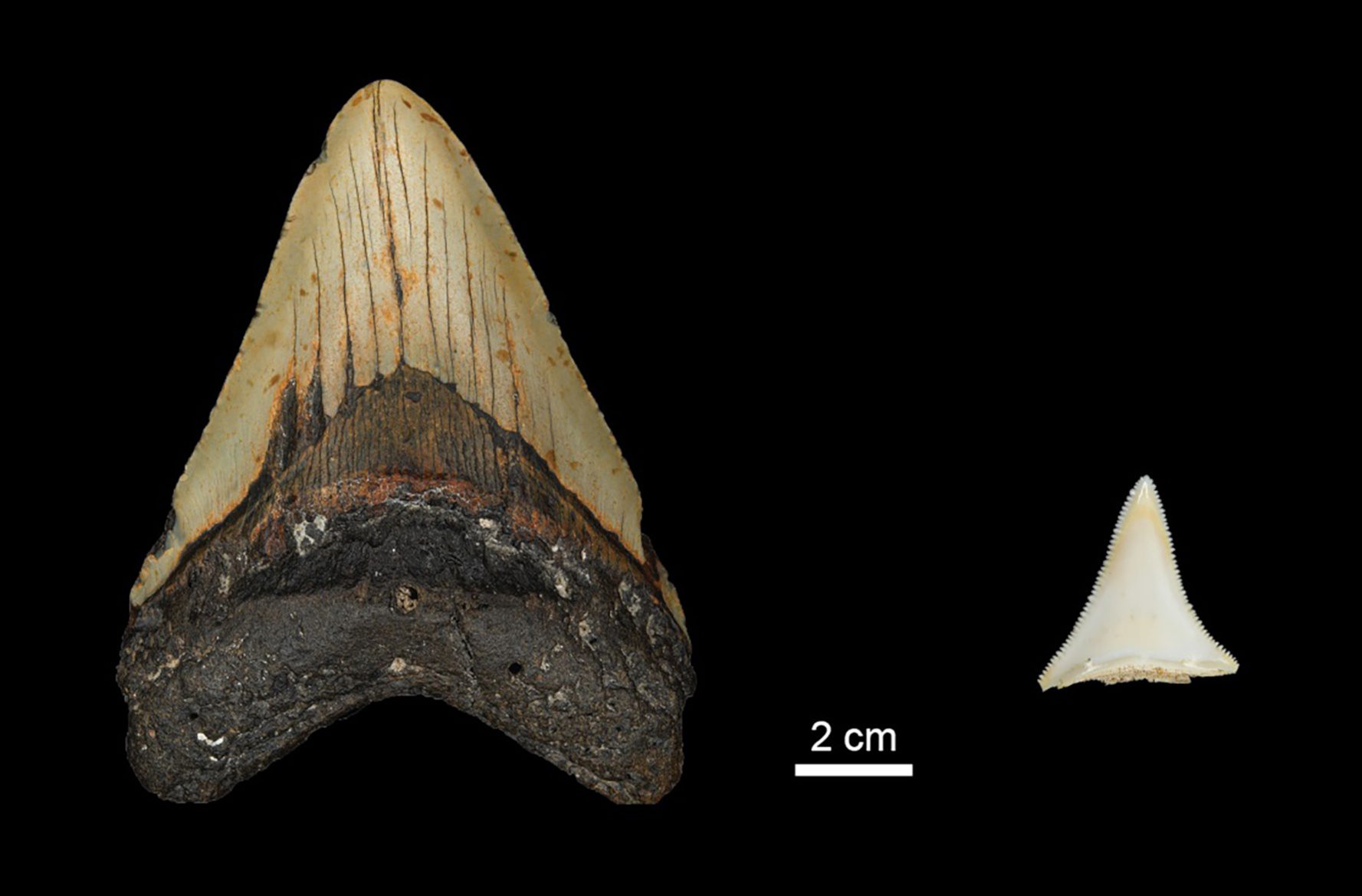Why did the largest shark ever die about 3.6 million years ago? A study now provides new evidence that the smaller but more adaptable great white shark snatched food from its giant relative: Comparisons of zinc isotope fingerprints in the fossil teeth of both shark species indicate that they hunted similar prey and were thus food competitors. Along with other factors, competitive pressures may have led to the demise of the wild beast, researchers say.
Huge teeth have been found at many sites around the world and are evidence of a giant shark that roamed the oceans about 3.6 million years ago. Triangular bites are sometimes larger than a human hand and indicate that Otodus megalodon reached nearly 20 meters in length. The great white shark (Carcharodon carcharias), which existed parallel to that time, almost looked like a dwarf about six meters across. But he has survived to this day – but his feral cousin has not. It has already been suggested that the great white shark may have played a role in the extinction of megalodon. Because he could have been a very important competitor in food. However, the extent to which the two predatory fish were chasing similar prey remains unclear.
On the diet trail
An international team of researchers has now gained insight into this question using a new detection method. She examined the effects of zinc (Zn) isotopes in the teeth of fossil sharks. As the scientists explain, it stands to reason that the ratio of 66Zn to 64Zn reflects the so-called nutritional level of sharks – the place they occupied in the food chain. In the sea, it begins with tiny algae that are eaten by small animals such as krill. These crustaceans in turn serve as food for the species that make up the next higher trophic level. For example, because baleen whales eat krill directly, they occupy a lower position than toothed whales or seals that harbor larger fish. At the highest trophic level are the predators of these marine mammals. As part of their study, the researchers have now discovered to what extent zinc isotope fingerprints allow conclusions to be drawn about the sharks’ diet.
The team analyzed the ratio of stable zinc isotopes in the teeth of modern and fossil sharks from around the world, including megalodon sharks and modern and fossilized great white sharks. As the researchers report, the fundamental potential of this method was initially activated: the nutritional level of different shark species was already reflected in the signatures and the values did not appear to have been falsified by fossilization processes either. “Zinc isotope signals are coherent in fossils and corresponding modern species. This strengthens our confidence in the analysis method,” says co-author Sora Kim from the University of California, Merced. “For the first time, we were able to extract Conclusions about the diet of these animals based on zinc isotope fingerprints in the highly mineralized enamel crown of fossil shark teeth.
A reference to food competition
In this way, the researchers were also able to determine the zinc isotope ratios of megalodon teeth from the early Pliocene (5.3 to 3.6 million years ago) and of great white sharks living then and now in order to get indications about the interactions that might occur there. was between them. “What is remarkable is that the zinc isotope values of the early Pliocene sharks from North Carolina indicate that the nutritional levels of the early great white sharks and the much larger megalodon overlapped quite a bit,” says co-author Michael Griffiths of William Patterson University in Wayne. “Our results suggest at least some overlap in the prey caught by both types of sharks,” adds his colleague Kensho Shimada of DePaul University in Chicago.
In addition to fish, sharks may have eaten a similar mixture of different marine mammals. Thus, this indication of competition for food resources also supports the suspicion that the great white played a critical role in the extinction of megalodon: it is possible that the smaller predator eventually had the fin in the foreground in the competitive struggle, which could have contributed to this. . to the demise of her giant relative. “However, more research is needed on this topic,” Shimada asserts.
Finally, first author Jeremy McCormack of the Max Planck Institute for Evolutionary Anthropology in Leipzig emphasized the far-reaching potential of the new detection method. Because it now represents an important addition to the nitrogen isotope analyzes of dental collagen, which previously provided conclusions about diets. “The protein collagen found in bone and teeth, which is required for these analyzes, is difficult to preserve long-term, so traditional nitrogen isotope analysis is often not possible,” McCormack says. “Our research shows that zinc isotopes can be used to reconstruct the diet and feeding environment of extinct animals over millions of years. This method is applicable to many groups, including our ancestors,” says the scientist.
Source: Max Planck Institute for Evolutionary Anthropology, article: Nature Communications, doi: 10.1038/s41467-022-30528-9

“Alcohol buff. Troublemaker. Introvert. Student. Social media lover. Web ninja. Bacon fan. Reader.”







More Stories
This is how our brain chooses what information it will remember in the long term
Up to 100 pilot whales stranded in Western Australia – Science
Huge radiation explosion from a magnetar – forschung.de